Welcome to our comprehensive guide on cat collar sizes. Proper fit is crucial for comfort and safety. This guide helps you choose the ideal collar size with essential tips and size charts for a perfect fit.
1.1 Importance of Proper Collar Fit for Cats
A proper collar fit is crucial for your cat’s safety, comfort, and health. A collar that’s too tight can cause skin irritation or breathing difficulties, while one that’s too loose may slip off. Ensuring the right fit prevents such issues, supporting your cat’s well-being. Always aim for a snug yet comfortable fit, allowing two fingers to slide underneath easily. This ensures your cat can move freely without discomfort or risk.
1.2 Overview of the Guide
This guide provides a detailed approach to selecting the perfect cat collar size. It covers essential topics like measuring techniques, size charts, and factors influencing fit. Whether your cat is a kitten or a senior, the guide offers tailored advice to ensure comfort and safety. From adjustable collars to breed-specific sizing, it helps you make informed decisions for your cat’s unique needs. Use this guide to find the ideal fit effortlessly.
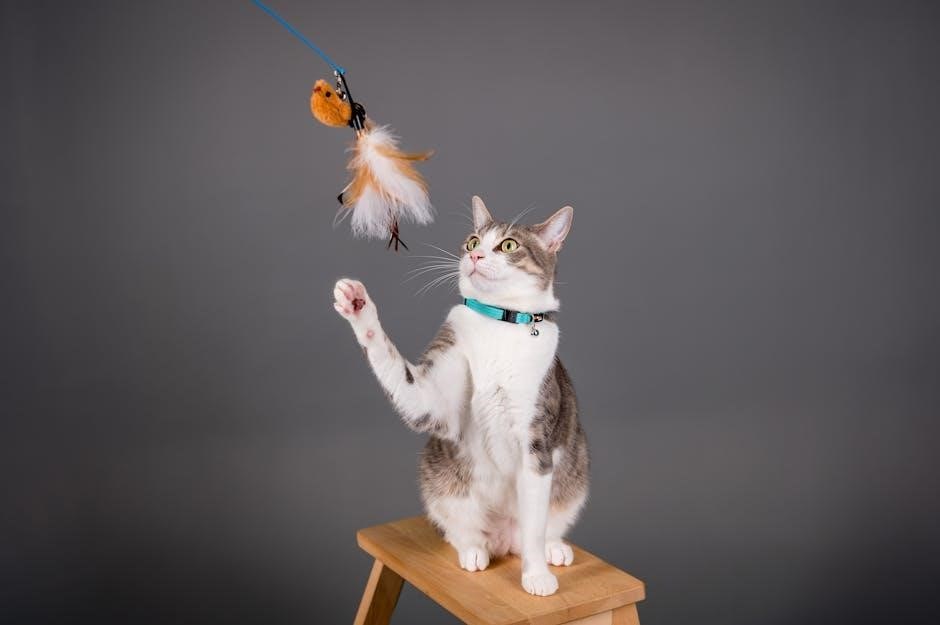
Understanding Cat Sizes and Breeds
Proper collar fit depends on your cat’s size and breed. Small breeds like Siamese, medium like Abyssinian, and large breeds require tailored sizing for comfort and safety.
2.1 Recognizing Different Life Stages: Kitten, Adult, and Senior Cats
Cats grow through distinct life stages, each requiring tailored collar sizing. Kittens (6-12 months) need smaller, adjustable collars (18-20cm neck size). Adults (1-7 years) typically fit standard sizes (19-28cm). Seniors may require more comfortable, breathable materials. Understanding these stages ensures proper fit and comfort, as weight and activity levels vary. This guide helps match collar size to your cat’s life stage for optimal safety and comfort.
2.2 Breed-Specific Sizing: Small, Medium, and Large Breeds
Collar sizing varies by breed due to differences in neck circumference. Small breeds like Siamese or Abyssinian typically fit collars for neck sizes 18-22cm. Medium breeds, such as Domestic Shorthairs, require 22-25cm. Large breeds, like Maine Coons, need collars for necks 25-30cm. Using breed-specific size charts ensures proper fit, accommodating variations in size and weight for optimal comfort and safety.
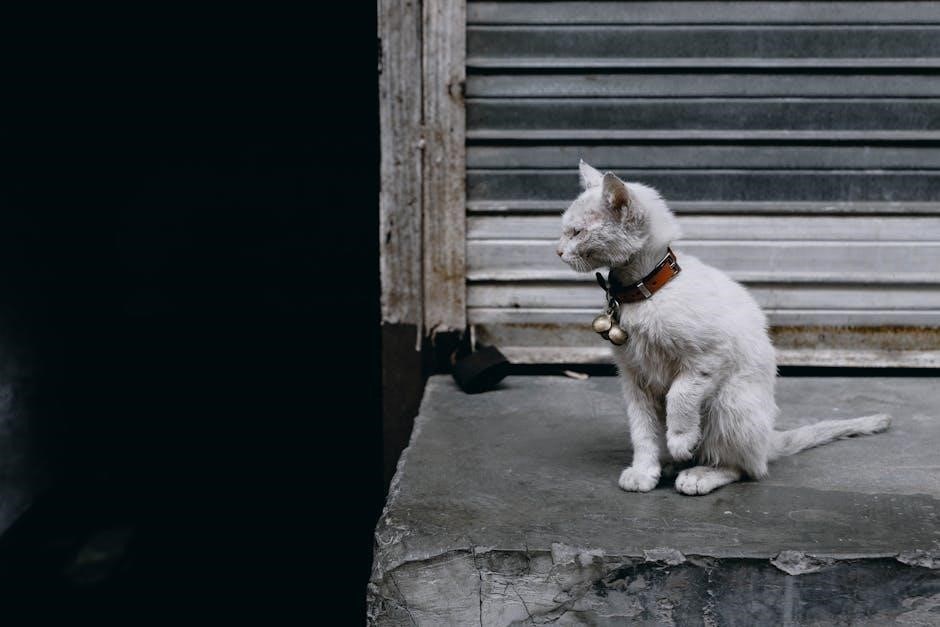
Measuring Your Cat’s Neck
Accurately measuring your cat’s neck is essential for a proper fit. Use a flexible tape measure around the base of the neck, ensuring it’s snug but not tight.
3.1 How to Accurately Measure Your Cat’s Neck Circumference
To measure your cat’s neck, use a flexible tape measure or a piece of string. Gently wrap it around the base of their neck, ensuring it’s snug but not tight. Allow room for two fingers to fit comfortably between the tape and your cat’s skin. Record the measurement carefully to ensure an accurate fit for their collar. This step is crucial for selecting the right size.
3.2 Factors Influencing Neck Size (Weight, Age, Breed)
A cat’s neck size is influenced by weight, age, and breed. Kittens grow rapidly, requiring adjustable collars, while adult cats’ sizes stabilize. Breeds like Siamese tend to have slender necks, while Maine Coons have thicker ones. Weight fluctuations and seasonal fur changes also impact fit. Monitoring these factors ensures the collar remains comfortable and secure. Regular adjustments may be needed to accommodate growth or weight changes for optimal comfort and safety.
Choosing the Right Collar Size
Accurately measure your cat’s neck and use size charts to ensure a proper fit. Adjustable collars offer flexibility, while breakaway options enhance safety. Always allow room for two fingers underneath for comfort and security.
4.1 Standard Collar Size Chart: Length and Adjustable Range
Standard collars typically range from 6 to 13 inches in length. Adjustable collars offer flexibility, with sizes accommodating necks from 7.9 to 11.8 inches. Widths are usually under 0.5 inches. Use size charts to match your cat’s neck circumference for a snug fit. Ensure two fingers fit comfortably underneath for optimal comfort and safety. Proper sizing prevents choking and ensures mobility.
4.2 Breakaway Collar Size Guide: Safety and Fit
Breakaway collars prioritize safety with a release mechanism to prevent choking. They come in sizes tailored to your cat’s weight, ensuring a secure yet comfortable fit. For kittens, collars adjust to neck sizes between 18-20cm, while adult cats range from 19-28cm. These collars are ideal for active cats, offering durability and safety. Always measure your cat’s neck and refer to size charts for the perfect fit, ensuring two fingers can slide underneath easily.
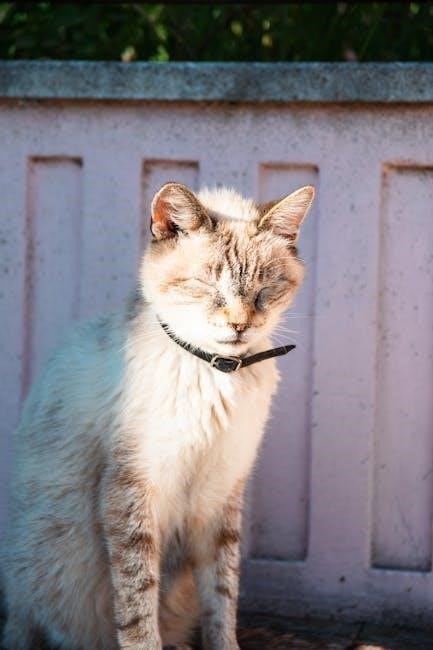
Adjustable vs. Fixed Collars
Adjustable collars offer flexibility for growing cats, while fixed collars provide a consistent fit. Choose based on your cat’s growth stage and lifestyle for optimal comfort and safety.
5.1 Benefits of Adjustable Collars for Growing Cats
Adjustable collars are ideal for kittens and growing cats, as they accommodate neck size changes without frequent replacements. They ensure a comfortable fit during development, preventing skin irritation and allowing room for growth. This feature is especially beneficial for kittens transitioning to adulthood, ensuring safety and comfort throughout their growth journey.
5.2 When to Use Fixed Collars: Specific Cases
Fixed collars are best for adult cats with stable neck sizes, as they provide a consistent fit. They are ideal for indoor cats or those with calm lifestyles, eliminating the need for adjustments. Fixed collars are also suitable for cats that do not pull or escape, ensuring a reliable and secure fit without compromising safety or comfort.
Material and Width Considerations
Collar width and material impact comfort and durability. Options include slim, standard, and wide widths, with materials like fabric, leather, or synthetic, catering to different lifestyles and preferences.
6.1 Collar Width: Standard, Slim, and Wide Options
Cat collars come in standard, slim, and wide widths. Standard collars are the most common, typically 0.5-1 inch wide, while slim collars are narrower for smaller cats. Wide collars, often 1.5 inches or more, distribute weight better and are ideal for large or active cats. The width should be proportional to your cat’s neck size and lifestyle for optimal comfort and support.
6.2 Material Types: Fabric, Leather, and Synthetic
Cat collars are available in fabric, leather, and synthetic materials. Fabric collars are soft and lightweight, ideal for sensitive cats. Leather collars are durable but may stiffness. Synthetic materials offer easy cleaning and water resistance. Choose based on your cat’s comfort, lifestyle, and maintenance preferences to ensure the best fit and satisfaction. Each material type caters to different needs, ensuring comfort and practicality.
Safety Features in Cat Collars
Safety features in cat collars include breakaway buckles and quick-release mechanisms. These ensure your cat’s safety if the collar gets caught, preventing accidents and injuries effectively always.
7.1 Breakaway Buckles: Importance and Function
Breakaway buckles are essential for cat safety. They release automatically when force is applied, preventing choking or injury if the collar gets caught. This feature is particularly vital for outdoor cats or those prone to slipping out of collars. Ensure the buckle is tailored to your cat’s weight for optimal functionality and reliability in emergencies, providing peace of mind for pet owners.
7.2 Quick-Release Mechanisms: Added Safety
Quick-release mechanisms enhance collar safety by allowing rapid removal in emergencies. They prevent accidental snagging and provide an extra layer of security, especially for active or outdoor cats. This feature complements breakaway buckles, offering peace of mind for pet owners. However, it’s important to ensure the mechanism is reliable and suitable for your cat’s weight and lifestyle to maintain both safety and functionality effectively.
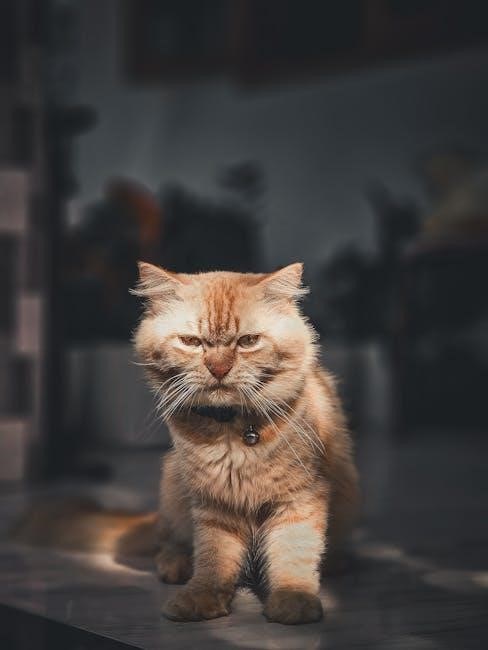
Size Charts for Popular Cat Collar Brands
Popular brands like Cheshire & Wain and Kitty Bling Boutique offer detailed size charts. Cheshire & Wain includes Petite, Standard, and Large sizes, while Kitty Bling features Kitten, Petite, and Regular options, ensuring a perfect fit for all cat sizes.
8.1 Cheshire & Wain Collar Sizes: Petite, Standard, and Large
Cheshire & Wain offers three distinct sizes. The Petite size suits kittens and small breeds, fitting necks 7-8.6 inches (18-22cm). The Standard size accommodates medium-sized cats with necks 9.2-11.8 inches (23.5-30cm). The Large size is designed for bigger breeds, fitting necks 12.2-14.6 inches (31-37cm). Each size ensures comfort and safety, with breakaway buckles tailored for specific weight ranges, making them ideal for pets weighing over 5.5lbs.
8.2 Kitty Bling Boutique Collar Sizes: Kitten, Petite, and Regular
Kitty Bling Boutique offers three collar sizes. The Kitten size is designed for younger cats, with a length of 10 inches (25cm) and adjustable to fit necks 7-8 inches (18-20cm). The Petite size suits small breeds, adjusting to necks 8-10 inches (20-25cm). The Regular size accommodates adult cats, fitting necks 10-13 inches (25-33cm). Each collar features a breakaway safety buckle, ensuring security and comfort for cats of various sizes and weights.
Weight Guidelines for Cat Collars
Weight guidelines help ensure proper fit and safety. Kitten collars suit cats under 2.5kg (5.5lbs), while adult collars are designed for cats over 2.5kg. Always match your cat’s weight to the collar size for optimal comfort and safety.
9.1 Weight Ranges for Kitten and Adult Collars
Kitten collars are designed for cats weighing under 2.5kg (5.5lbs), ensuring a safe and comfortable fit for smaller breeds. Adult collars typically cater to cats over 2.5kg, providing durability and support. Always choose collars with adjustable features to accommodate growth and weight changes, ensuring your cat’s comfort and safety throughout their life stages.
9.2 Matching Weight to Collar Size for Safety
Matching your cat’s weight to the correct collar size is essential for their safety and comfort. Kittens under 2.5kg (5.5lbs) require smaller, lightweight collars, while adult cats over this weight need sturdier options. Adjustable collars help accommodate growth and ensure a proper fit. Always choose collars with safety features like breakaway buckles to prevent choking hazards, ensuring your cat’s well-being at every life stage.
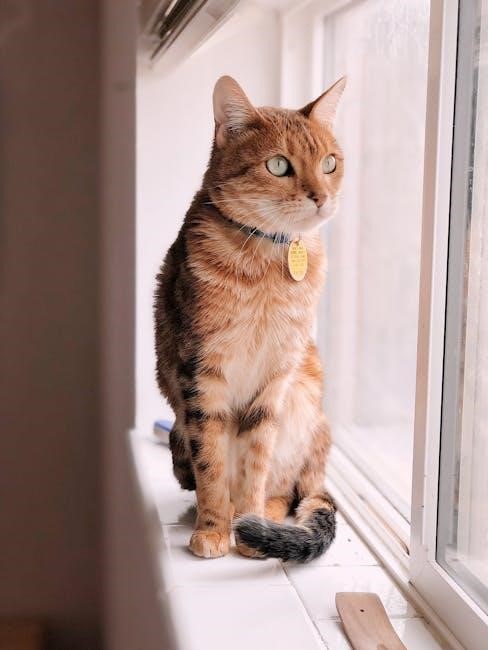
How Should a Collar Fit?
A well-fitted collar should allow two fingers to slide comfortably under it, ensuring your cat’s safety and comfort without restricting movement or causing irritation.
10.1 The Two-Finger Rule: Ideal Snugness
The two-finger rule ensures your cat’s collar is snug yet comfortable. Gently insert two fingers between the collar and your cat’s neck. If you can fit them without force, the fit is perfect. This prevents choking and allows free movement. Proper snugness is vital for safety and comfort, ensuring your cat can breathe easily and move naturally without the collar slipping or causing distress.
10.2 Signs of a Proper Fit: Comfort and Mobility
A properly fitting collar ensures your cat’s comfort and mobility. Your cat should be able to move its head and neck freely, with the collar neither digging into the skin nor slipping over the ears. The collar should allow for two fingers of space and not restrict breathing or movement. Look for signs like no redness or irritation and the collar staying securely in place without shifting down or sideways.

Factors Influencing Collar Size
Fur thickness and seasonal changes can affect collar size, requiring adjustments. Thicker fur may need a slightly larger size, while shedding may necessitate tightening the collar for a proper fit.
11.1 Fur Thickness and Seasonal Changes
Fur thickness significantly impacts collar fit, as thicker coats require slightly larger sizes. Seasonal shedding or fur growth can alter neck measurements, necessitating adjustments. Cats with long or double coats may need more room to prevent discomfort. Regular checks ensure the collar remains comfortable and secure, avoiding skin irritation or restricted movement. Adjustable collars are ideal for accommodating these changes throughout the year.
11.2 Activity Level and Lifestyle
A cat’s activity level and lifestyle greatly influence collar fit. Active or outdoor cats may require collars with breakaway buckles for safety. Indoor cats or those with lower activity levels may prefer lighter, simpler designs. Cats that grow or shed seasonally benefit from adjustable collars to maintain comfort. Monitoring your cat’s lifestyle helps ensure the collar remains secure and comfortable, adapting to their changing needs and movements.
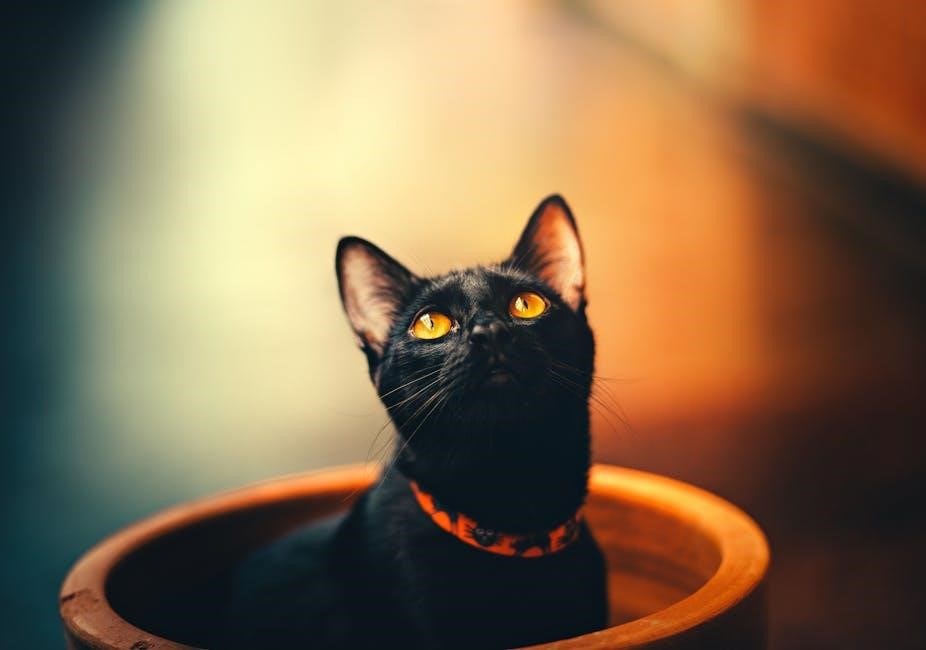
Adjusting the Collar for Seasonal Changes
Adjust your cat’s collar seasonally to accommodate fur and weight changes. Loosen in winter and tighten in summer for optimal comfort. Regular checks ensure fit.
12.1 Winter vs. Summer Collar Adjustments
During colder months, cats often gain weight and develop thicker fur, requiring a slightly looser collar fit. In summer, shedding reduces neck size, so tighten the collar for comfort. Regular monitoring ensures optimal fit year-round.
Seasonal adjustments prevent discomfort and potential health issues. Use adjustable collars for ease of resizing, ensuring your cat’s safety and well-being through all seasons.
12.2 Monitoring Weight Changes
Regularly monitor your cat’s weight as fluctuations can affect collar fit. Weight gain may require a larger size, while loss might need a smaller one. Use size charts to adjust accordingly. Ensure the collar remains snug but not tight, allowing two fingers to fit comfortably. Adjustments maintain comfort and prevent health issues related to an ill-fitting collar.
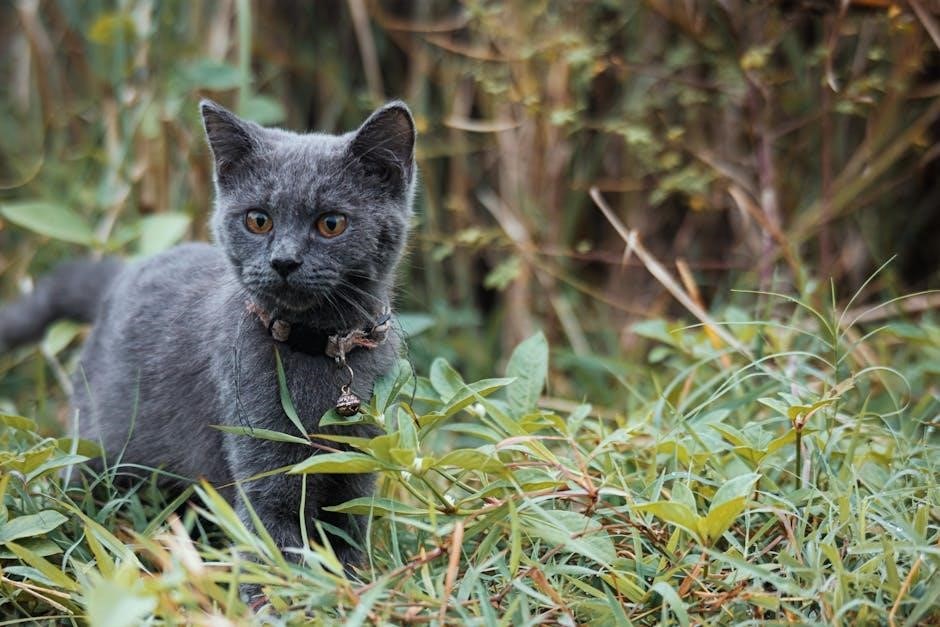
Tips for Ensuring Comfort and Safety
Regularly check collar fit to ensure comfort and avoid skin irritation. Avoid over-tightening, as it can restrict breathing. Use the two-finger rule for ideal snugness and adjust as needed.
13.1 Regular Checks for Proper Fit
Regularly inspect your cat’s collar to ensure it hasn’t become too tight or loose. Check for signs of wear and tear, such as fraying or broken buckles. Adjust the collar as needed, especially during growth phases or weight changes. Use the two-finger rule to confirm a snug yet comfortable fit, allowing for easy movement without constriction.
13.2 Avoiding Over-Tightening
Avoid over-tightening your cat’s collar, as it can restrict movement and breathing. Use the two-finger rule to ensure a snug fit without discomfort. Regularly check the collar, especially during growth or weight changes. A tight collar can cause skin irritation or stress. Ensure your cat can move freely and comfortably, adjusting the collar as needed to maintain the perfect balance between safety and comfort.
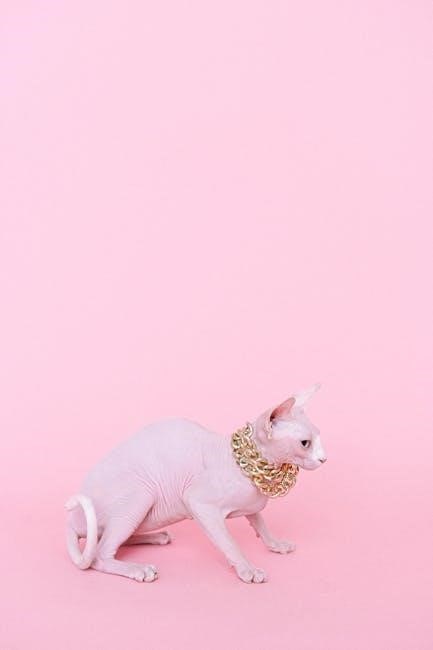
Common Mistakes to Avoid
Common mistakes include relying solely on weight for sizing and ignoring activity levels. Always measure neck circumference and consider lifestyle to ensure proper fit and comfort for your cat.
14.1 Relying Solely on Weight for Sizing
Relying only on weight for sizing is a common mistake. Weight doesn’t account for neck size, fur thickness, or body shape. For example, a lean cat and a fluffy cat of the same weight may need different collar sizes. Always measure your cat’s neck circumference and refer to size charts for an accurate fit. Adjustable collars are ideal for growing cats or those with fluctuating weights.
14.2 Ignoring the Cat’s Activity Level
Ignoring your cat’s activity level is a critical mistake when choosing a collar. Active cats, especially outdoor ones, may require more durable or safety-focused collars, such as breakaway styles, to prevent accidents. Indoor cats may prefer lighter, slimmer designs. Always consider your cat’s lifestyle to ensure the collar is suitable for their daily activities and movements.
This guide provides a comprehensive approach to selecting the perfect cat collar. Proper fit ensures comfort, safety, and style. Always measure accurately and consider your cat’s activity level and lifestyle for the best fit.
15.1 Summary of Key Points
Proper collar fit is essential for your cat’s comfort and safety. Measure your cat’s neck accurately, consider their weight, breed, and activity level. Adjustable collars are ideal for growing cats, while breakaway buckles ensure safety. Avoid over-tightening and opt for materials that suit your cat’s lifestyle. Regularly check the fit and adjust as needed. This guide provides a clear path to selecting the perfect collar for your feline companion.
15.2 Encouragement to Use the Guide Effectively
By following this guide, you’ll ensure your cat’s collar is both safe and comfortable. Take the time to measure accurately and consider your cat’s lifestyle. Adjustable collars offer flexibility, while breakaway buckles provide added security. Regularly check the fit and adjust as needed. With these steps, you’ll create a tailored solution for your cat’s unique needs, ensuring their happiness and well-being for years to come.



